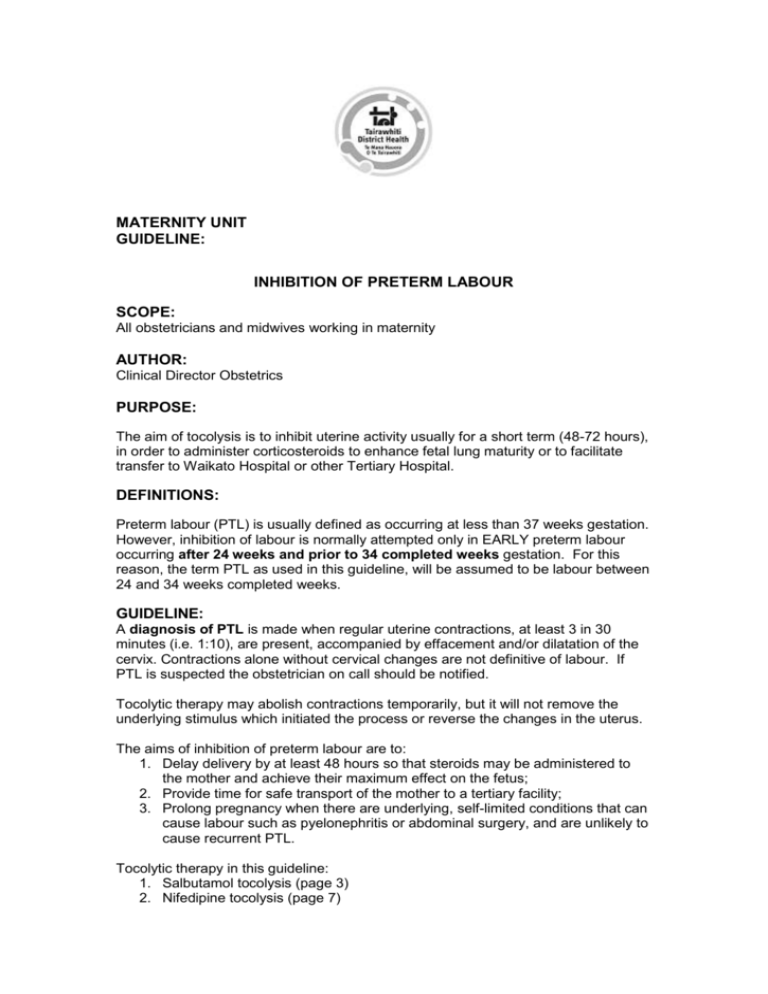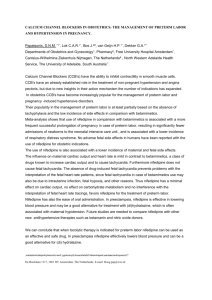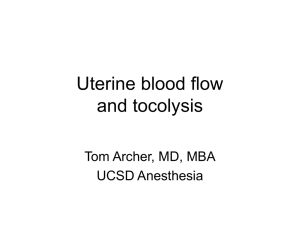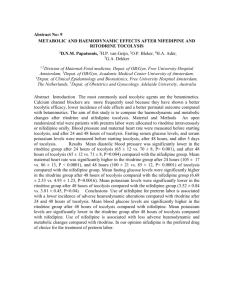MATERNITY UNIT GUIDELINE: Inhibition of preterm labour SCOPE
advertisement

MATERNITY UNIT GUIDELINE: INHIBITION OF PRETERM LABOUR SCOPE: All obstetricians and midwives working in maternity AUTHOR: Clinical Director Obstetrics PURPOSE: The aim of tocolysis is to inhibit uterine activity usually for a short term (48-72 hours), in order to administer corticosteroids to enhance fetal lung maturity or to facilitate transfer to Waikato Hospital or other Tertiary Hospital. DEFINITIONS: Preterm labour (PTL) is usually defined as occurring at less than 37 weeks gestation. However, inhibition of labour is normally attempted only in EARLY preterm labour occurring after 24 weeks and prior to 34 completed weeks gestation. For this reason, the term PTL as used in this guideline, will be assumed to be labour between 24 and 34 weeks completed weeks. GUIDELINE: A diagnosis of PTL is made when regular uterine contractions, at least 3 in 30 minutes (i.e. 1:10), are present, accompanied by effacement and/or dilatation of the cervix. Contractions alone without cervical changes are not definitive of labour. If PTL is suspected the obstetrician on call should be notified. Tocolytic therapy may abolish contractions temporarily, but it will not remove the underlying stimulus which initiated the process or reverse the changes in the uterus. The aims of inhibition of preterm labour are to: 1. Delay delivery by at least 48 hours so that steroids may be administered to the mother and achieve their maximum effect on the fetus; 2. Provide time for safe transport of the mother to a tertiary facility; 3. Prolong pregnancy when there are underlying, self-limited conditions that can cause labour such as pyelonephritis or abdominal surgery, and are unlikely to cause recurrent PTL. Tocolytic therapy in this guideline: 1. Salbutamol tocolysis (page 3) 2. Nifedipine tocolysis (page 7) 3. Magnesium sulfate tocolyis (page 11) Contraindications and precautions: Tocolysis is contraindicated when the maternal/fetal risks of prolonging pregnancy or the risks associated with these drugs are greater than the risks associated with preterm birth. Contraindications include: Intrauterine death Lethal fetal anomaly Non-reassuring fetal status Severe fetal growth restriction Maternal cardiac disease Maternal cardiac arrhythmia Placental abruption Thyrotoxicosis Uncontrolled diabetes Sensitivity to sympathomimetic drugs (does not apply to magnesium sulfate or nifedipine use) Relative contraindications of inhibition of preterm labour include: suspected amnionitis gestational age >34 weeks major fetal anomaly abnormal CTG suspected placental abruption severe pre-eclampsia intrauterine growth retardation intrauterine infection Inhibition of PTL is less likely to be successful where cervical dilatation is greater than 3cms. Tocolysis may still be beneficial however in order to administer maternal steroids or safely transport the mother to a tertiary unit. On admission - If PTL strongly suspected, go to management of preterm labour guideline, otherwise assess situation and: 1. Inform Consultant Obstetrician immediately 2. Maternal examination for signs of infection - temp, pulse, respiration rate 3. Abdominal examination – palpate and assess for; uterine contractions, uterine tone, uterine tenderness, fetal and uterine size. Palpate for lie, presentation, position and engagement. 4. Ask woman for clean catch MSU specimen when possible and send to laboratory 5. Commence CTG and monitor continuously until consultant has made a decision and management plan. 6. Any leakage of fluids or vaginal discharge – go to preterm premature rupture of the membranes guideline The Consultant will formulate a plan of care - This plan may include the following: Speculum examination – this will allow an inspection for ruptured membranes or infection as well as cervical dilatation – take fetal fibronectin sample prior to any digital examination and only lubricate the speculum with warm water - see fetal fibronectin guideline and flow chart AmniSure test for rupture of membranes High vaginal swab (HVS), cervical cultures Complete Blood Count and other blood tests as clinically indicated Insert IV line and commence intravenous therapy Inform Neonatal Unit staff/paediatrician of potential admission and update them as to ongoing management plan Corticosteroid injection if <34 weeks gestation unless delivery is imminent Nifedipine, salbutamol, Terbutaline or Magnesium Sulphate regime as per protocol as recommended by Consultant Obstetrician Consideration of transfer out to a tertiary unit – see transfer out of maternity patients guideline The selection of an appropriate labour-inhibiting agent should be based upon efficacy and safety. If the first tocolytic agent does not inhibit PTL successfully, the obstetrician may consider discontinuing this and commencing a second agent. However it is important to exclude intrauterine infection as this may be a contraindication to continuing tocolytic therapy. There is no high quality evidence of the efficacy of bedrest for the prevention or treatment of PTL in singleton pregnancy. 1/ Salbutamol tocolysis Salbutamol may be used in cases of threatened/confirmed pre term labour (PTL) before 34 weeks with no obstetric pathology, until 24 hours after last dose of steroids are given, and where the Nifedipine regime cannot be used. An obstetrician must order and prescribe salbutamol. Drug action and presentation Salbutamol is a betametic agent and acts as uterine muscle relaxant, by stimulating Beta-2 adrenergic receptors in smooth muscle. It comes in 0.5mg/ml and 1 mg/ml ampoules Dose 5mg Salbutamol in 100mls normal saline (gives a dilution of 50mcg/ml) Administered via an electronic control device (e.g. IVAC, syringe driver), as a second line, piggybacked into a mainline of Hartmans/Normal Saline. Incompatibilities Do not mix with any other drugs and only piggyback onto mainline Hartmans or Normal Saline. Contraindications, use with precaution and side effects Contraindications: Where urgent delivery is appropriate, e.g. fetal distress or IUGR Amnionitis Significant antepartum haemorrhage Significant pre-eclampsia or eclampsia Thyrotoxicosis Hypersensitivity to Beta-adrenergic drugs Use with precaution: Any cardiac disease Diabetes (see side effects) Side effects: General tachycardia (rise in heart rate by 20-50 bpm), palpitations, nausea and vomiting, tremor, constipation and headaches are common. Pulmonary oedema, chest discomfort, cough, tachypnoea and shortness of breath may indicate pulmonary oedema. Most cases are due to fluid overload and can be prevented by using a concentrated solution of Salbutamol. It is more common in women with twins and undiagnosed cardiac disease. Carbohydrate metabolism, blood glucose levels increase up to 40% and insulin secretion increases. Hypokalaemia commonly occurs and may require treatment. Myocardial Ischaemia – due to increase cardiac output.(rare) Hypotension, secondary to vasodilatation (rare). Fetal tachycardia (rise by 20 bpm) for duration of Salbutamol. Maternal hyperglycaemia and hyperinsulinism can cause hypoglycaemia of the infant after birth. Insulin dependent diabetics will rapidly become hyperglycaemic and may develop ketoacidosis. It will be necessary to run an insulin infusion, monitored by hourly blood glucose estimations. The combination of Salbutamol and steroids in a diabetic may only be used with the approval of the on call obstetrician Continuous infusion rate of salbutamol If there are no side effects, add 5mg Salbutamol to 100mls of Normal Saline IV fluid to give a dilution of 50mcg/ml Administer infusion via the side arm, i.e. piggy backed into mainline using an electronic control device, e.g. an IVAC Commence at 2.5mcg/minute Increase the rate every 10 minutes as outlined below, UNTIL contractions cease. Rate (mls/hour) Dose (mcg/min) 3 2.5 6 5.0 12 10.0 18 15.0 24 20.0 30 25.0 36 30.0 42 35.0 48 40.0 Stop infusion if: Maternal pulse rate exceeds 140bpm Maternal systolic BP is less than 100mmHg Maternal respiration greater than 24/minute Coughing – see side effects Chest pain – see side effects Fetal heart rate greater than 180bpm When contractions have ceased, or maximum dosage has been reached, this is the maintenance dose. It may be necessary to reduce the dose slightly for comfort. Monitoring During the establishment of an effective dosage, at 10 minute intervals and before each increase in dose, record and document in the clinical notes the following: Record at 10 minute intervals: Maternal pulse (must be less than 140 bpm) Maternal respiratory rate (must be no more than 24 rpm) Fetal heart rate (ensure it is less than 180 bpm) Frequency of contractions and dose of drug Other records include: Baseline temperature, then 4 hourly Continuous CTG Commence fluid balance chart/records Test urine for glucose and protein 6 hourly Maternal blood tests:– electrolytes (U & E’s), glucose and CBC (for WBC) At commencement, 6 hours after commencement and then 12 hourly while on maintenance dose until completion. Once on maintenance dose: Observations are ½ hourly for 2 hours and then hourly. After 6-8 hours of stable recordings reduce to: hourly maternal pulse hourly recording of contractions, record dosage of Salbutamol 4 hourly BP, T&R Fetal heart – 8 hourly CTG for no less than 30 minutes Note: A progressive increase in fetal heart rate and/or maternal fever and/or abdominal tenderness may indicate amnionitis. Try to find an effective maintenance dose and continue at this level for 12 hours after the last steroid has been given. Antibiotics should be used when the membranes are ruptured or when the cervix is 3cm or more dilated with intact membranes as per PPROM and Group B Strep guideline. Steroids given as per obstetric orders U&E results must be followed up promptly as oral or IV Potassium replacement may be required. Stopping the infusion Keep Salbutamol at maintenance level for 12 hours following last steroid injection then discontinue infusion. (1/2 life of Salbutamol is 4-6 hours). 2/ Nifedipine Tocolysis Trade Name – Nyefax Retard 20 mgs tablets (slow release Nifedipine) Adalat 5 mg capsules (short acting Nifedipine) Mechanism of action – both forms of Nifedipine are calcium channel blockers and act as uterine relaxants. Indications: Acute tocolysis in patients with pre-term labour after 24 weeks gestation and before 34 weeks gestation Consent for procedure Nifedipine 5 mg Capsules are covered under Section 29 and not registered for use in New Zealand. Prior to commencing this procedure, information should be given to the woman by the obstetrician or the midwife, about the drug and why it is recommended and patient consent must be obtained and documented in the clinical notes. A register of doses administered must be completed and is found in the medical store room in DU. Dose schedule (see flow chart on page 9) Initial doses Tocolysis with short acting Nifedipine is initiated with 10mgs orally. After 15 minutes, if still uterine activity, then a second dose of short acting Nifedipine 10 mgs can be given. If contractions still persist, further 10mg doses can be given every 15 minutes for a maximum for 4 doses. Note that the maximum dose in the first hour is 40 mgs. Maintenance dose Depending on the effectiveness of the tocolytic given in the first hour, a maintenance dose of 60 – 160 mgs per day of slow release Nifedipine is then given. The obstetrician must chart the required dose regime (see page 8 for dosage levels). This is until the steroid medication has been administrated and completed. The dose of slow release Nifedipine may be increased during the time of administration. The first slow release Nifedipine may be given at the same time as the last dose of short acting Nifedipine. It is preferable to give slow release Nifedipine 8 hourly to ensure a steady plasma level. Dosage levels: It has been found that a dosage level of 20mgs – 40mgs – 20mgs of slow release Nifedipine is suitable for most women. On occasions a higher dose may be necessary in which case the maximum dose is 60mgs – 40mgs – 60mgs this is given 8 hourly (160mgs in 24 hours). Likewise the minimum dose of slow release Nifedipine is 20mgs - 20mgs – 20mgs (8 hourly). The obstetrician must prescribe which dose is required on an individual patient basis on the medication chart or using a verbal telephone order (see safe management of medicines policy) The administration of Nifedipine (slow release) is usually discontinued 12 hours after the last steroid dose as there is currently insufficient evidence to support the continued use after steroid administration is complete. Maternal considerations: Monitoring On administering Nifedipine during the first hour, pulse and blood pressure should be checked every 30 minutes After the first hour, pulse and blood pressure should be checked every hour for two hours. Three hours after commencement, pulse and blood pressure should be checked four hourly once uterine activity has ceased. If there is any concern (fetal or maternal) then the observations should be maintained at more frequent intervals as clinically indicated. Please note: Normotensive women on Nifedipine experience a minimal drop in blood pressure, however, pre–eclamptic women can experience an acute drop in blood pressure and this must be considered carefully before commencement. Fetal considerations: Continuous CTG from commencement of Nifedipine therapy and then for at least one hour until uterine activity ceases. Clinical assessment of uterine activity is also important to assess and document. It is essential that the CTG be within normal limits before Nifedipine is administered. If there is any change in the clinical situation at other intervals, e.g. increase in maternal temperature or pulse rate or return/increase of uterine activity, then CTG monitoring should be recommenced. Contraindications Maternal: Absolute Suspected uterine infection Suspected placental abruption or significant APH Shock Hypotension Previous allergic response to Nifedipine Relative Use of Magnesium Sulphate (risk hypotension) Use of Beta-blocker (risk hypotension) Precautions Heart disease/arrhythmia’s Liver disease Fetal: Severe IUGR Gestational age of >34 weeks Abnormal CTG/fetal distress Side effects Transient palpitations (0 – 6%) Headaches (5 – 6%) Facial flushing (5 – 18%) Less common side effects are: constipation, dizziness, nausea, tachycardia, fatigue, peripheral oedema and increased liver enzymes. Liver enzyme changes are not a concern with such limited use, but are of concern in those with known liver disease. Changing from salbutamol to nifedipine If a woman has already commenced on Salbutamol then the infusion should be stopped. Usual observations for Salbutamol use should be continued until the maternal pulse rate drops below 100. At this stage the Nifedipine protocol can commence using short acting Nifedipine if the patient is contracting or slow release Nifedipine at a dosage of 20 – 40 – 20mgs if uterine activity has ceased. NIFEDIPINE TOCOLYSIS FLOWCHART-PLEASE SEE HARDCOPY IN WARD FOR THIS 3/ Magnesium Sulfate The precise mechanism of magnesium’s effects on uterine contractions has not been completely discovered, despite more than 40 years of study. Magnesium probably competes with calcium at the level of the plasma membrane voltage-gated channels. It hyperpolarizes the plasma membrane and inhibits myosin light-chain kinase activity by competing with intracellular calcium at this site. Interference with the activity of myosin light-chain kinase reduces myometrical contractility. A randomised controlled trial comparing magnesium sulfate with nifedipine for acute tocolysis found no significant differences in rate of delivery within 48 hours or in any neonatal morbidity. Contraindications: Women with Myasthenia Gravis Known myocardial compromise Impaired renal function Concurrent use with Nifedipine Side effects Maternal: Rapid infusion causes: Flushing and warmth Diaphoresis (excessive sweating commonly associated with shock and other medical emergency conditions) Probably related to peripheral vasodilation and a drop in BP Other side effects include: Nausea Vomiting Headache Visual disturbances Palpitations Loss of deep tendon reflexes (at doses of 9.6 to 12.0mg/dl) Respiratory paralysis (at doses of 12.0 to 18.0mg/dl) Cardiac arrest (at doses of 24.0 to 30.0mg/dl) Fetal: Conflicting data with regard to effect on perinatal mortality Slight decrease in fetal heart rate and variability (not clinically significant) Doses: 4-6g bolus, followed by a maintenance dose of 1-2g/hr. The infusion rate should be titrated based upon assessment of contraction frequency and maternal toxicity. Calcium gluconate 1g IV over 5 to 10 minutes should be administered only to counteract life-threatening symptoms of magnesium toxicity such as cardiorespiratory compromise When used with calcium-channel blockers there is a risk of suppression of heart rate, contractility and left ventricular systolic pressure and neuromuscular blockade. All preterm labour In all cases of suspected preterm labour, please follow the flow chart in appendix 1 in consultation with the obstetrician. Premature labour <34weeks is a level 3 Section 88 referral, 34 – 36 weeks is a level 2 referral. Note that Terbutaline Sulfate is NOT AVAILABLE in New Zealand ASSOCIATED DOCUMENTS Maternity Unit guideline – Transfers out of maternity patients Maternity Unit guideline - Fetal fibronectin Maternity Unit guideline – Preterm labour and delivery Maternity Unit guideline – Preterm rupture of the membranes Maternity Unit guideline – Referral of neonates to the paediatric service Maternity Unit guideline – Emergencies obstetric and neonatal Organisational Policy - Safe management of medicines Appendix 1 – Recommended management of woman with threatened preterm labour REFERENCES Ministry of Health (2007) maternity Services: Notice Pursuant to Section 88 of the New Zealand Public Health and Disability Act 2000. Waikato guidelines for salbutamol and nifedipine tocolysis Up to date on-line (2007) Inhibition of acute preterm laboutr. Downloaded on 7 may 2008 from: http://www.utdol.com/online/content/topic.do?topicKey=pregcomp/11591&view=print # Date of Approval: May 2008 Next Review Date: May 2010 PLEASE SEE HARDCOPY IN WARD FOR APPENDIX 1









